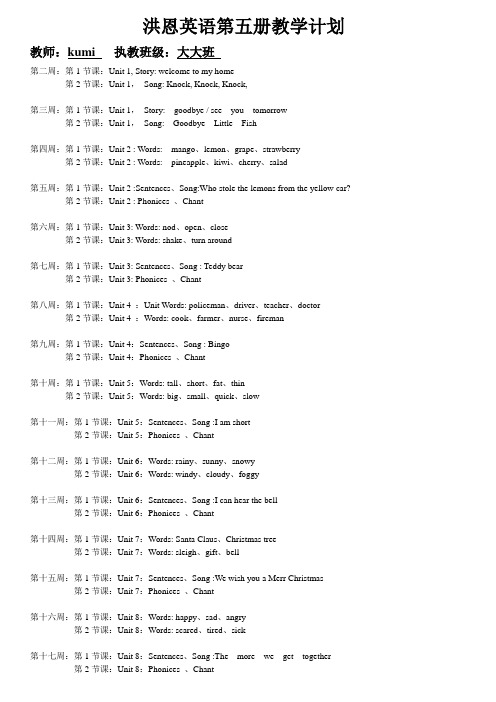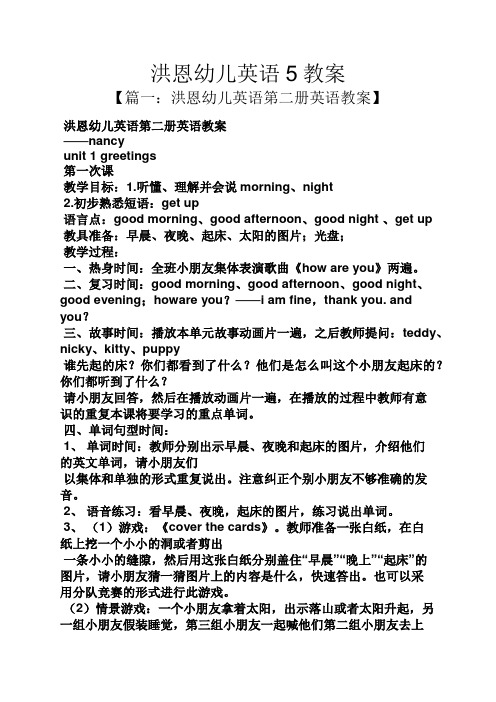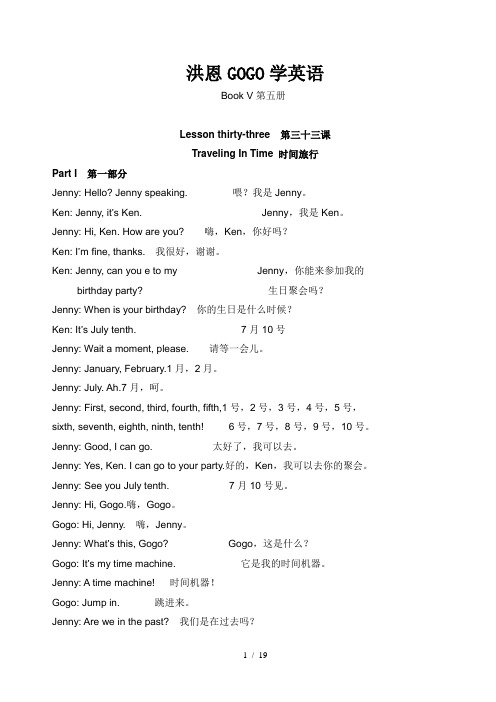洪恩new bravo5 lesson6教学内容
- 格式:ppt
- 大小:2.92 MB
- 文档页数:11

洪恩英语第五册教学计划教师:kumi 执教班级:大大班第二周:第1节课:Unit 1, Story: welcome to my home第2节课:Unit 1,Song: Knock, Knock, Knock,第三周:第1节课:Unit 1,Story: goodbye / see you tomorrow第2节课:Unit 1,Song: Goodbye Little Fish第四周:第1节课:Unit 2 : Words: mango、lemon、grape、strawberry第2节课:Unit 2 : Words: pineapple、kiwi、cherry、salad第五周:第1节课:Unit 2 :Sentences、Song:Who stole the lemons from the yellow car?第2节课:Unit 2 : Phonices 、Chant第六周:第1节课:Unit 3: Words: nod、open、close第2节课:Unit 3: Words: shake、turn around第七周:第1节课:Unit 3: Sentences、Song : Teddy bear第2节课:Unit 3: Phonices 、Chant第八周:第1节课:Unit 4 :Unit Words: policeman、driver、teacher、doctor 第2节课:Unit 4 :Words: cook、farmer、nurse、fireman第九周:第1节课:Unit 4:Sentences、Song : Bingo第2节课:Unit 4:Phonices 、Chant第十周:第1节课:Unit 5:Words: tall、short、fat、thin第2节课:Unit 5:Words: big、small、quick、slow第十一周:第1节课:Unit 5:Sentences、Song :I am short第2节课:Unit 5:Phonices 、Chant第十二周:第1节课:Unit 6:Words: rainy、sunny、snowy第2节课:Unit 6:Words: windy、cloudy、foggy第十三周:第1节课:Unit 6:Sentences、Song :I can hear the bell第2节课:Unit 6:Phonices 、Chant第十四周:第1节课:Unit 7:Words: Santa Claus、Christmas tree第2节课:Unit 7:Words: sleigh、gift、bell第十五周:第1节课:Unit 7:Sentences、Song :We wish you a Merr Christmas 第2节课:Unit 7:Phonices 、Chant第十六周:第1节课:Unit 8:Words: happy、sad、angry第2节课:Unit 8:Words: scared、tired、sick第十七周:第1节课:Unit 8:Sentences、Song :The more we get together 第2节课:Unit 8:Phonices 、Chant洪恩英语第一册教学计划教师:Funny 执教班级:中班第二周:第1节课:Unit 1, Story: Hi/Hello,Teddy/Kitty/第2节课:Unit 1,Mommy/Daddy/第三周:第1节课:Unit 1,Song: Hello song第2节课:Unit 1,Song: Daddy mommy I love you 。

关于洪恩幼儿英语升级版第六册第二单元的教学内容分析一、教学内容概述1.1 本单元教学内容为动物园,介绍了不同种类的动物及其特点,教育幼儿对动物的保护意识和爱护动物的重要性。
1.2 本单元内容涵盖了动物的外貌特征、生活习性、饮食习惯等方面的知识,通过生动有趣的教学内容,激发幼儿对动物的好奇心和学习兴趣。
1.3 本单元的教学目标旨在引导幼儿积极参与课堂活动,通过观察和讨论,学习掌握一些关于动物的英语词汇,并能够简单描述动物的外貌和习性。
二、教学内容分析2.1 词汇学习在本单元中,孩子们将学习到关于各种动物的词汇,包括它们的名称及外貌特征。
比如:lion(狮子)、elephant(大象)、zebra(斑马)等等。
教师应通过图片、卡通或实物等多种形式展示动物形象,辅以清晰的发音教学,引导幼儿正确学习单词的发音和拼写。
2.2 句型学习教师在课堂上引导学生学习掌握描述动物外貌和习性的简单句型,例如:The lion is big and strong. The elephant has a long nose. The zebra has black and white stripes. 通过教学活动和练习,帮助幼儿掌握这些简单句型,从而能够描述动物的外貌和一些基本的生活习性。
2.3 语音和语调训练针对幼儿英语学习的特点,教师应重点训练幼儿的语音和语调,帮助他们正确发音并准确表达。
在学习动物名称时,要注意重点音节的发音和语调的变化,以提高幼儿的语音表达能力。
2.4 手工制作和表演教师可以设计一些手工制作活动,让幼儿动手制作与动物相关的手工制品,如动物面具、动物拼贴画等,同时组织幼儿进行小小表演,通过亲身参与,增强幼儿对动物的了解和记忆。
三、教学方法及策略3.1 多媒体教学利用多媒体教学手段,如幻灯片、视瓶等,生动展示动物形象和栩栩如生的动物生活场景,激发幼儿的学习兴趣,提高他们对英语学习的积极性。
3.2 游戏教学在课堂中,教师可以设计一些趣味性的游戏,如记忆卡片游戏、动物模仿游戏等,让幼儿在玩中学,达到轻松愉快的学习效果。

牛津小学英语5A Unit 6 教案教学设计◆您现在正在阅读的牛津学校英语5A Unit 6 教案教学设计文章内容由Teaching Procedures:Step1:Revision1.Free talk.T:Good afternoon,××Glad to see you.S1:Glad to see you, Miss Xue.T: I like singing. What do you like?S1: I likenning.T: What day is to day?S2:Today is Tuesday.T: Ho are you? T:Ho about your father?S2:I’m fine. S2:He’s fine.T:Are you free no?S2:Yes, I am. / No, I’m not.T:Where are you no, class?Ss:We’re at the English lesson./We’re in the classroom.2.Say a chant. What can you do?Step2 Presentation1.Make a call.提示课题。
T: Hello, ××What day is today?S1:Today is Tuesday.T: It’s a nice day, isn’t it?S2:Yes, it is .T: Hello, ××It’s a nice day. Do you like this morning? S3:Yes.T:Are you free no?Shall e go to Hongmei Zoo?S4:All right / Great!T: This class e’ll learn to make a call.揭示课题:T:Look at this. Say after me.Make a call.Ss:Make a call .T:No here is a telephone. Let’s make a call.2、创设情境,学习打电话方式。

洪恩幼儿英语5教案【篇一:洪恩幼儿英语第二册英语教案】洪恩幼儿英语第二册英语教案——nancyunit 1 greetings第一次课教学目标:1.听懂、理解并会说morning、night2.初步熟悉短语:get up语言点:good morning、good afternoon、good night 、get up教具准备:早晨、夜晚、起床、太阳的图片;光盘;教学过程:一、热身时间:全班小朋友集体表演歌曲《how are you》两遍。
二、复习时间:good morning、good afternoon、good night、good evening;howare you?——i am fine,thank you. and you?三、故事时间:播放本单元故事动画片一遍,之后教师提问:teddy、nicky、kitty、puppy谁先起的床?你们都看到了什么?他们是怎么叫这个小朋友起床的?你们都听到了什么?请小朋友回答,然后在播放动画片一遍,在播放的过程中教师有意识的重复本课将要学习的重点单词。
四、单词句型时间:1、单词时间:教师分别出示早晨、夜晚和起床的图片,介绍他们的英文单词,请小朋友们以集体和单独的形式重复说出。
注意纠正个别小朋友不够准确的发音。
2、语音练习:看早晨、夜晚,起床的图片,练习说出单词。
3、(1)游戏:《cover the cards》。
教师准备一张白纸,在白纸上挖一个小小的洞或者剪出一条小小的缝隙,然后用这张白纸分别盖住“早晨”“晚上”“起床”的图片,请小朋友猜一猜图片上的内容是什么,快速答出。
也可以采用分队竞赛的形式进行此游戏。
(2)情景游戏:一个小朋友拿着太阳,出示落山或者太阳升起,另一组小朋友假装睡觉,第三组小朋友一起喊他们第二组小朋友去上床睡觉或者起床。
睡觉前要说“good night”起床要说:good morning。
五、延伸活动:请小朋友用英语叫爸爸妈妈起床,并使用礼貌用语:good morning。


洪恩GOGO学英语Book V第五册Lesson thirty-three 第三十三课Traveling In Time 时间旅行Part I 第一部分Jenny: Hello? Jenny speaking. 喂?我是Jenny。
Ken: Jenny, it’s Ken. Jenny,我是Ken。
Jenny: Hi, Ken. How are you? 嗨,Ken,你好吗?Ken: I’m fine, thanks. 我很好,谢谢。
Ken: Jenny, can you e to my Jenny,你能来参加我的birthday party? 生日聚会吗?Jenny: When is your birthday? 你的生日是什么时候?Ken: It’s July tenth. 7月10号Jenny: Wait a moment, please. 请等一会儿。
Jenny: January, February.1月,2月。
Jenny: July. Ah.7月,呵。
Jenny: First, second, third, fourth, fifth,1号,2号,3号,4号,5号,sixth, seventh, eighth, ninth, tenth! 6号,7号,8号,9号,10号。
Jenny: Good, I can go. 太好了,我可以去。
Jenny: Yes, Ken. I can go to your party.好的,Ken,我可以去你的聚会。
Jenny: See you July tenth. 7月10号见。
Jenny: Hi, Gogo.嗨,Gogo。
Gogo: Hi, Jenny. 嗨,Jenny。
Jenny: What’s this, Gogo? Gogo,这是什么?Gogo: It’s my time machine. 它是我的时间机器。
Jenny: A time machine! 时间机器!Gogo: Jump in. 跳进来。
Unit 6 Doing Housework一Teaching Requirements:1.Can master “four-ables”words and phrases:morning,ring,sweep,Maths,sleep,jump,run,walk,help...with,wash,clothes. 2.Master “four-ables”sentence patterns:What is/are ...doing?He's/She's /I'm/We're/They're ...3.Can master “three-ables” everyday communication phrases and sentences: Are you free now? How about...?Can you come and help ...with ...?See you this afternoon. Please help me.Please give me some ...Yes, you're right. Sorry, you're wrong.第1页共19页4.Know the pronunciation of vowel letter “e” in words.5. Can sing the song: What are you doing?二Teaching difficult points and important points:1.Can master “four-ables” words and phrases2.Can master “four-ables”sentences patterns.三Teaching preparation:1.Text pictures,tape recording.2. Telephone.One一Teaching requirements:1.Preliminary learning of the text,know telephone phrases and the present第2页共19页tense.2.Learn and master “four-ables” words,phrases.二Teaching difficult points and important points:Know telephone phrase and the present tense.三Teaching process:第3页共19页第4页共19页第5页共19页第6页共19页板书:What's he/she doing?He's/She's ...What are you doing?I'm/We're ...What am I doing?You're ...第7页共19页Two一.Teaching requirements:1.Can master and use the sentences of the unit,learn to usethe telephone phrases skillfully.2.Conduct a situational dialogue and can master “three-ables”sentences :Are you free now?How about ...?Can you come and help ... with ...?See you this afternoon.Please help me.二.Teaching process:第8页共19页第9页共19页第10页共19页板书:unit 6What are you doing?I’m…..第11页共19页Three一.Teaching requirements:1.Know the pronunciation of vowal letter “e” in words.2.Learn the song “What are you doing?”3.Strengthen pupil's knowledge of the patterns and words ofthis unit.二.Teaching difficult points and important points:Strengthen pupils knowledge of the patterns and words ofthis unit.三. Teaching process:第12页共19页第13页共19页第14页共19页板书:unit 6What is he/she doing?He/She’s …..Four一. Teaching requirements:1.Review this unit and skillfully master the sentence patternsof this unit.prehensive exercises.第15页共19页二. Teaching difficult points and important pointsReview this unit and skillfully master the sentence patterns. 三.Teaching process:第16页共19页第17页共19页第18页共19页教后反思:第19页共19页。
教学目标:听懂理解并会说出“short tall fat thin ”。
教具准备:一棵树、食物的卡片若干、一个月亮、TEDDY的头饰、火箭神八教学过程:1.Warm—up 猪八戒背媳妇的律动2.Story—time 本节课以故事贯穿TEDDY走着走着突然看见一个又大又漂亮的月亮,“Oh,a bright moon ,so beautiful .I want to touch the moon.”但是TEDDY太矮了,摘不到。
引出“I am short。
”并通过TPR 进行演练与互动。
摘不到月亮怎么办呢?怎么才可以长高呢?TEDDY says:”I want some more food .”接着继续走,遇见了一颗长满了食物的树,TEDDY开始吃起来了,然后长高了,引出“I am tall。
”通过高与矮的对比,和小朋友们吃了食物以后长高的变化,进行演练。
TEDDY长高了,还是摘不到月亮,于是TEDDY又开始吃东西,吃了好多巧克力,奶油,结果变胖了。
引出:“I am fat。
”通过TPR和变胖以后的行动不便进行演练。
TEDDY太胖了,需要减肥了。
引出“I am thin。
“通过一段减肥操的练习,进行演练。
最后还是只摘不到月亮。
于是,神舟八号出现了。
OK!Let us go by the rocket!3.Song—time课程教案(Book5—Unit2)教学内容:Hello Teddy 第五册第二单元phonics教学进度:字母M m以及其相对应的自然拼音的教授字母M为开头的单词mouse, mango, monkey, milk教学目标:掌握字母M的自然拼音发音,并正确读出包含M字母发音的单词。
会做M的字母及自然拼音操。
能准确的说出M字母的自然拼音儿歌。
教具准备:学过自然拼音的字母卡片;各种水果的图片和“mouse”、“mouth”、“meat”、“mommy”、“morning”、“monkey”、“milk”、“mango”的图片;字母M的自然拼音和韵律儿歌动画光盘。
Unit5 第6课时教案第六课时【学习目标】1、能在英文动画片和图片的帮助下,听出课文内容的大意,能在录音的帮助下,正确的跟读、朗读课文对话,做到发音清晰、语音语调正确。
并能够在图片的帮助下,正确的复述课文。
2、在问答句型的基础上老师引导学生正确寻找出关键信息,从而回答与课文相关的问题。
能独立完成短文后的练习题。
【评价设计】1、针对学习目标1,可以通过观察学生观看时的表情,指名提问、观察学生的口型、观察同桌或小组合作、提问某小组或某同桌进行对话操练、学生互评,来达到能清晰、正确说出单词或句子,敢于开口、积极参与对话交流、检测学生语言综合应运能力的目的。
2、针对学习目标2,采用教师提问,小组讨论问题、指名回答问题,指名上讲台书写,学生在书本上书写,巡视学生书写情况的方法来检测。
(达成率85%)【教学重难点】重点:操练巩固本单元11个职业名称和重点句型:What does he/she do? Where does he/she work? How does he/she go to work?难点:帮助学生理解短文中的新语言:help the bank use their money well, likes helping people, help tourists find their way【课前准备】1、Let’s read部分的教学录音带。
2、有关职业的单词卡片。
3、要求四会掌握的句型卡。
4、Main scene部分的教学课件。
四、教学步骤和建议1、W arm up (热身)活动一:读一读请学生个人或小组分别朗读、表演A, B部分Let’s learn和Let’s talk以及A Let’s read的内容。
活动二:拼单词(1)教师让一个学生到前面表演一个表示职业的动作,其他学生要说出他做的动作是哪一个职业单词。
(2)如果单词说对了,再让另一个学生拼出该单词。
活动三:猜一猜(1)教师出示Main scene部分的图片(Main scene 1/2 no words.gif),学生看图回答:Who’s that man?What does the man do?Where does he work?How does Zip go to school?(2)教师再出示图片(Main scene 1/2 with words. .jpg),让学生看一看正确答案。